Plant Ecology Laboratory
Research in our lab focuses on diversity patterns in biological communities, and on the interactions underlying these patterns. The main questions we address are: how do communities vary along natural gradients and gradients of human impact? What are the major assembly rules shaping communities; and are they attributable to biotic interactions or environmental heterogeneity? What are the roles of different biotic interactions - including competition, facilitation, herbivory and symbiosis - in structuring communities? Read more
News
Specialisation in arbuscular mycorrhizas
December 2018
Siim-Kaarel and others published a paper in Molecular Ecology, where they used exhaustive sampling of a plant community and network analysis methods to demonstrate host preference in arbuscular mycorrhizal (AM) symbiosis. Despite the low number of AM fungal species available for this ubiquitous symbiosis with most land plants, not all partners are equal. From the plant side, there was apparent symbiont preference with forbs and facultatively mycorrhizal plants (ones who can live with mycorrhiza and without) being more selective of their fungal partners.
Yearly meeting of the Estonian Mycological Society
December 2018
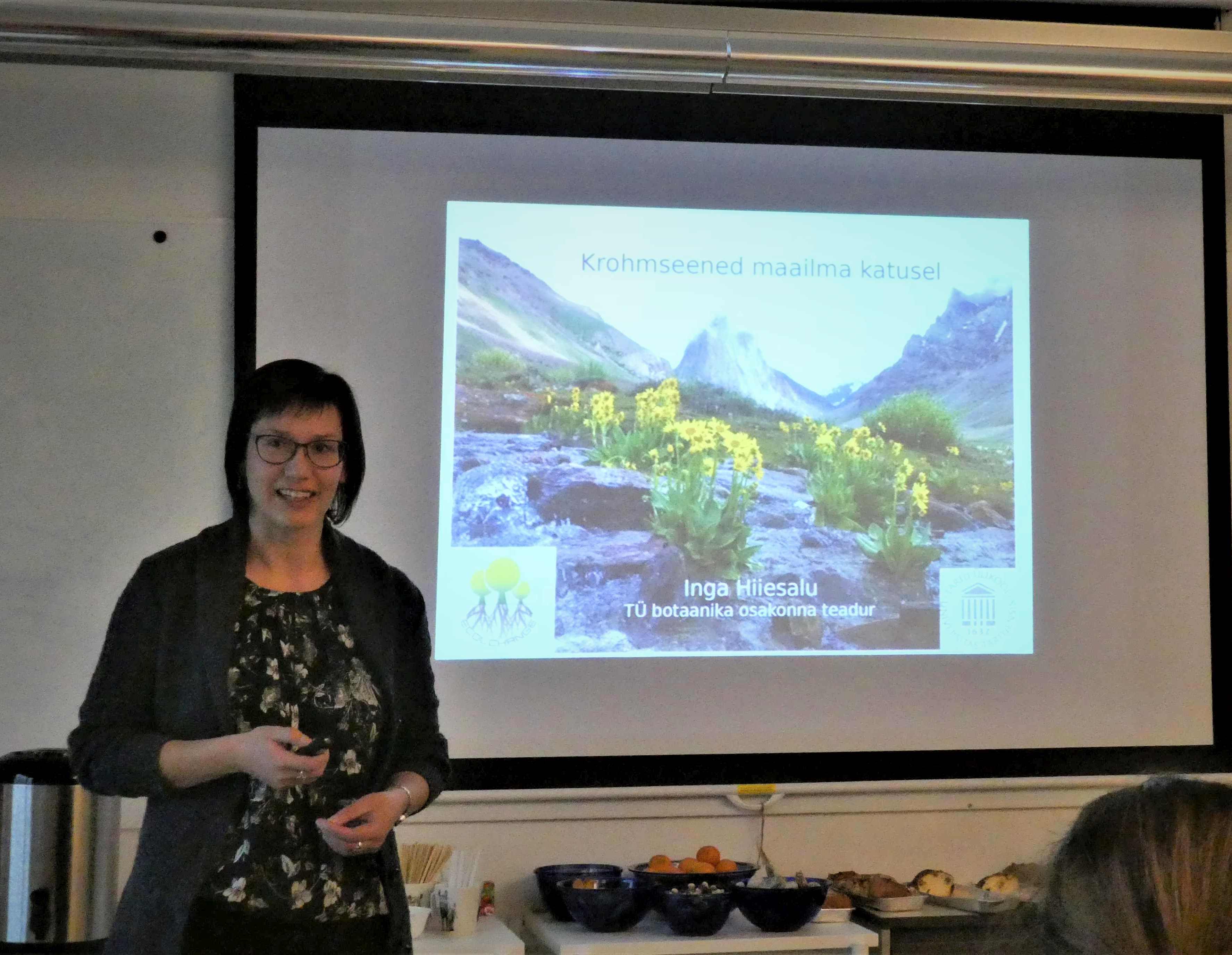 On 8th of December, the Estonian Mycological Society held its yearly meeting called Actiones. Among others, Jane Oja, who recently defenced her PhD gave a talk on orchid mycorrhiza and researcher Inga Hiiesalu presented her project on AM fungi in high-altitude Himalayas. In addition to presentations, the member of the Mycological Society voted for the Mushroom of the Year 2019, which is Coprinus comatus – shaggy ink cap!
On 8th of December, the Estonian Mycological Society held its yearly meeting called Actiones. Among others, Jane Oja, who recently defenced her PhD gave a talk on orchid mycorrhiza and researcher Inga Hiiesalu presented her project on AM fungi in high-altitude Himalayas. In addition to presentations, the member of the Mycological Society voted for the Mushroom of the Year 2019, which is Coprinus comatus – shaggy ink cap!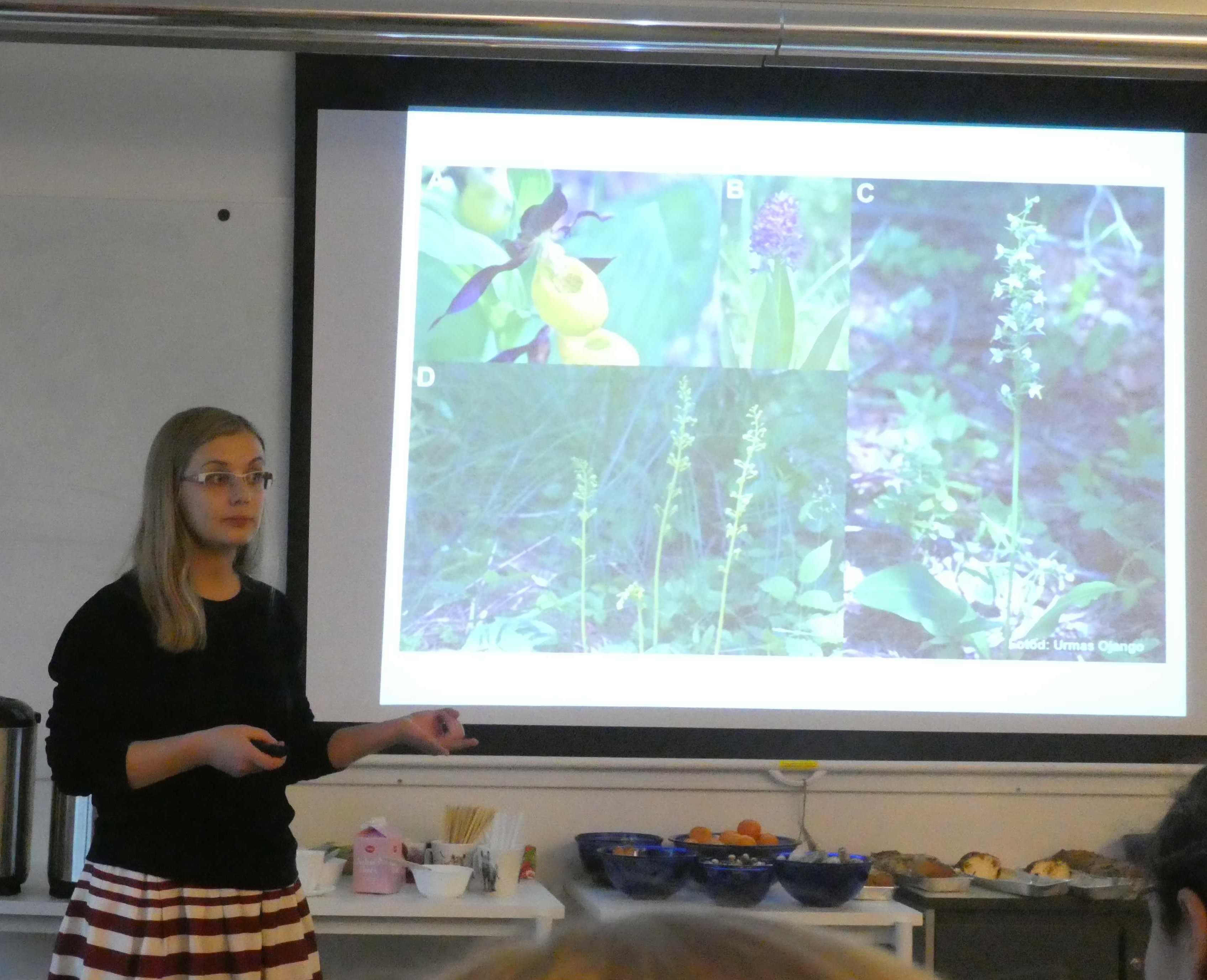
We welcome Claudia! Visting post-doc from Brazil
December 2018
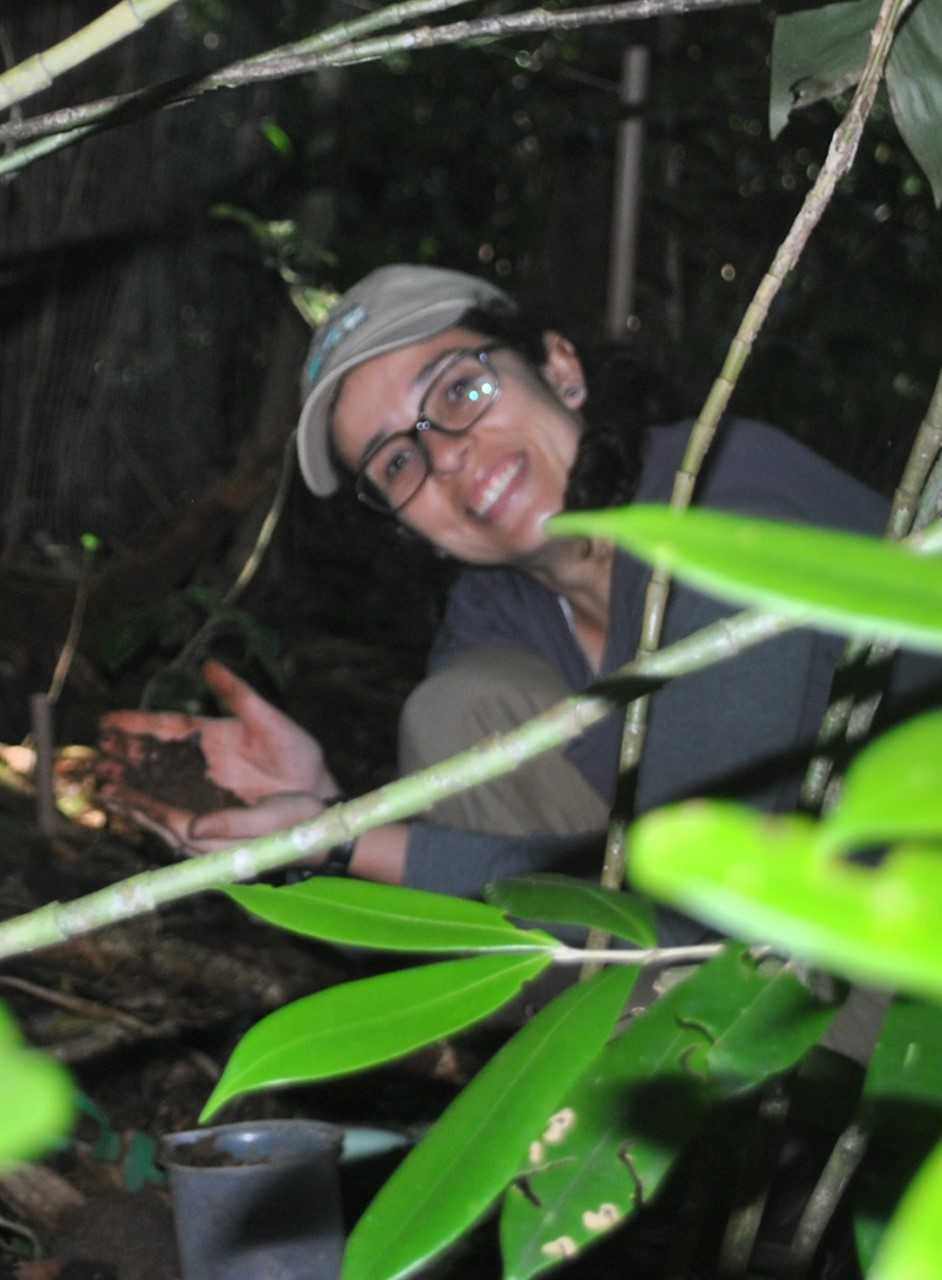 Claudia is a postdoctoral fellow from São Paulo State University (UNESP, Brazil) investigating the ecological consequences of the loss of large herbivores, for the diversity of plants and associated arbuscular mycorrhizal fungi in the Atlantic Forest. As part of her research, she is in Tartu to learn about the molecular and statistical techniques to identify and analyse the fungal community data from soil and root samples collected in a long-term experiment in Brazil. She is supervised by Maarja Öpik and eager to establish new collaborations with students and researchers here. We welcome Claudia and wish her an interesting and fruitful stay here in Tartu!
Claudia is a postdoctoral fellow from São Paulo State University (UNESP, Brazil) investigating the ecological consequences of the loss of large herbivores, for the diversity of plants and associated arbuscular mycorrhizal fungi in the Atlantic Forest. As part of her research, she is in Tartu to learn about the molecular and statistical techniques to identify and analyse the fungal community data from soil and root samples collected in a long-term experiment in Brazil. She is supervised by Maarja Öpik and eager to establish new collaborations with students and researchers here. We welcome Claudia and wish her an interesting and fruitful stay here in Tartu!
World soil day 2018
December 2018
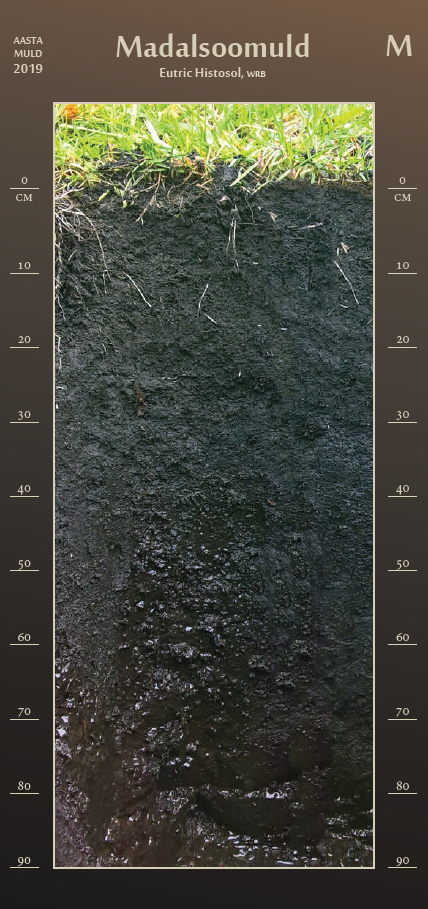 On the 5th of December, the world celebrates international soil day. Festivities also took place in Tartu, where the University of Life Sciences held a traditional Soil Day conference. This year the main subject of the conference was soil biota. From our working group, Maarja Öpik gave a presentation about soil fungi, followed by other presentations about arthropods, bacteria and mites. On this day, it has also become a tradition to announce the Estonian soil of the year. In 2019, it will be Eutric Histosol, wet and delicate! These soils, once abundant in Estonia, are very fragile when agriculturally managed and are in the forefront of action against carbon emissions and climate change.
On the 5th of December, the world celebrates international soil day. Festivities also took place in Tartu, where the University of Life Sciences held a traditional Soil Day conference. This year the main subject of the conference was soil biota. From our working group, Maarja Öpik gave a presentation about soil fungi, followed by other presentations about arthropods, bacteria and mites. On this day, it has also become a tradition to announce the Estonian soil of the year. In 2019, it will be Eutric Histosol, wet and delicate! These soils, once abundant in Estonia, are very fragile when agriculturally managed and are in the forefront of action against carbon emissions and climate change.
Special issue of New Phytologist brings 5 new papers from our team!
November 2018
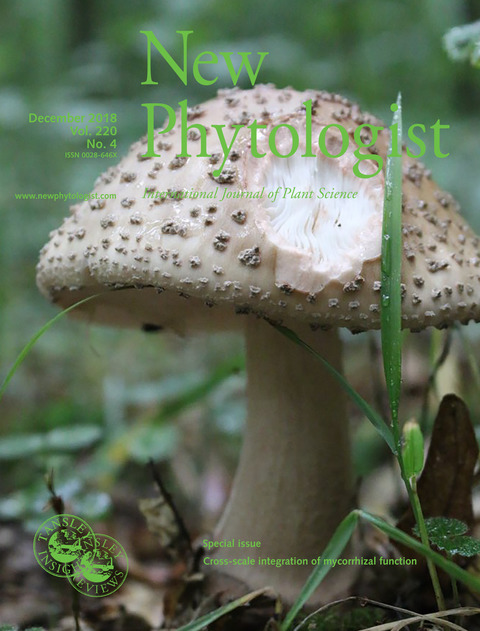 With the last issue of New Phytologist our team published five scientific papers! This is a special issue stemming from International Conference on Mycorrhizas (ICOM9) held last year in Prague. The papers range from case studies to methodological tests, conceptual discussion and commentary. We show how arbuscular mycorrhizal fungi live on grasslands when you abandon their management, or when you (over)fertilise them, explore and discuss optimal ways to see invisible – how to detect AM fungal species and what would that species be, and place in context new knowledge about how mycorrhizal symbionts mattered when plants “moved back” to postglacial new habitats. We also thank our collaborators from China, US, Canada and Finland!
With the last issue of New Phytologist our team published five scientific papers! This is a special issue stemming from International Conference on Mycorrhizas (ICOM9) held last year in Prague. The papers range from case studies to methodological tests, conceptual discussion and commentary. We show how arbuscular mycorrhizal fungi live on grasslands when you abandon their management, or when you (over)fertilise them, explore and discuss optimal ways to see invisible – how to detect AM fungal species and what would that species be, and place in context new knowledge about how mycorrhizal symbionts mattered when plants “moved back” to postglacial new habitats. We also thank our collaborators from China, US, Canada and Finland!
*Bruns TD, Corradi N, Redecker D, Taylor JW, Öpik M. 2018. Glomeromycotina: what is a species and why should we care? New Phytologist 220: 963–967.
*Jiang, S, Liu, Y, Luo, J, Qin, M, Johnson, N, Öpik, M, Vasar, M, Chai, Y, Zhou, X, Mao, L, et al. 2018. Dynamics of arbuscular mycorrhizal fungal community structure and functioning along a nitrogen enrichment gradient in an alpine meadow ecosystem. New Phytologist 220: 1222–1235.
*Lekberg Y, Vasar M, Bullington LS, Sepp S-K, Antunes PM, Bunn R, Larkin BG, Öpik M. 2018. More bang for the buck? Can arbuscular mycorrhizal fungal communities be characterized adequately alongside other fungi using general fungal primers? New Phytologist 220: 971–976.
*Neuenkamp L, Moora M, Öpik M, Davison J, Gerz M, Männistö M, Jairus T, Vasar M, Zobel M. 2018. The role of plant mycorrhizal type and status in modulating the relationship between plant and arbuscular mycorrhizal fungal communities. New Phytologist 220: 952–953.
*Zobel M. 2018. Eltonian niche width determines range expansion success in ectomycorrhizal conifers. New Phytologist 220: 947–949.
International Conference EcoBalt 2018 in Vilnius
October 2018
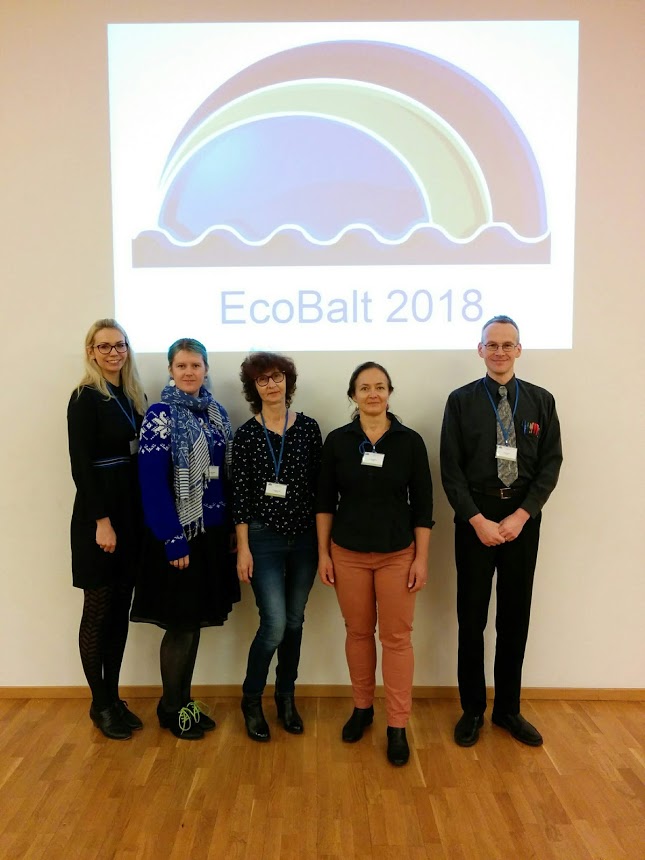 Researchers of environmental, analytical and green chemistry of Baltic countries assembled in Vilnius, Lithuania at EcoBalt conference to share newest knowledge in their research areas. Knowledge of biotic environment was shared by a member of our team, Maarja Öpik, who explained in her presentation why should we care about soil microbiota. Estonian researchers were represented by Ivo Leito from Tartu University, Merike Vaher and Piret Saar-Reismaa from TalTech and Siiri Saaver from Estonian Environmental Research Centre.
Researchers of environmental, analytical and green chemistry of Baltic countries assembled in Vilnius, Lithuania at EcoBalt conference to share newest knowledge in their research areas. Knowledge of biotic environment was shared by a member of our team, Maarja Öpik, who explained in her presentation why should we care about soil microbiota. Estonian researchers were represented by Ivo Leito from Tartu University, Merike Vaher and Piret Saar-Reismaa from TalTech and Siiri Saaver from Estonian Environmental Research Centre.
Raquel Juan Ovejero, a visiting PhD student from Spain
October 2018
 Raquel is a PhD student from the University of Vigo (Spain) studying soil fauna and carbon dynamics in peatlands. Here in Tartu she is learning about fungal communities in peatlands, and I will get familiarized with DNA extraction and approaches to identify fungi by using DNA sequences with some soil samples collected her my study sites in north-western Spain. She is being supervised by Maarja Öpik.
Raquel is a PhD student from the University of Vigo (Spain) studying soil fauna and carbon dynamics in peatlands. Here in Tartu she is learning about fungal communities in peatlands, and I will get familiarized with DNA extraction and approaches to identify fungi by using DNA sequences with some soil samples collected her my study sites in north-western Spain. She is being supervised by Maarja Öpik.
Influence of disturbance on AM fungi of French Guiana
June 2018
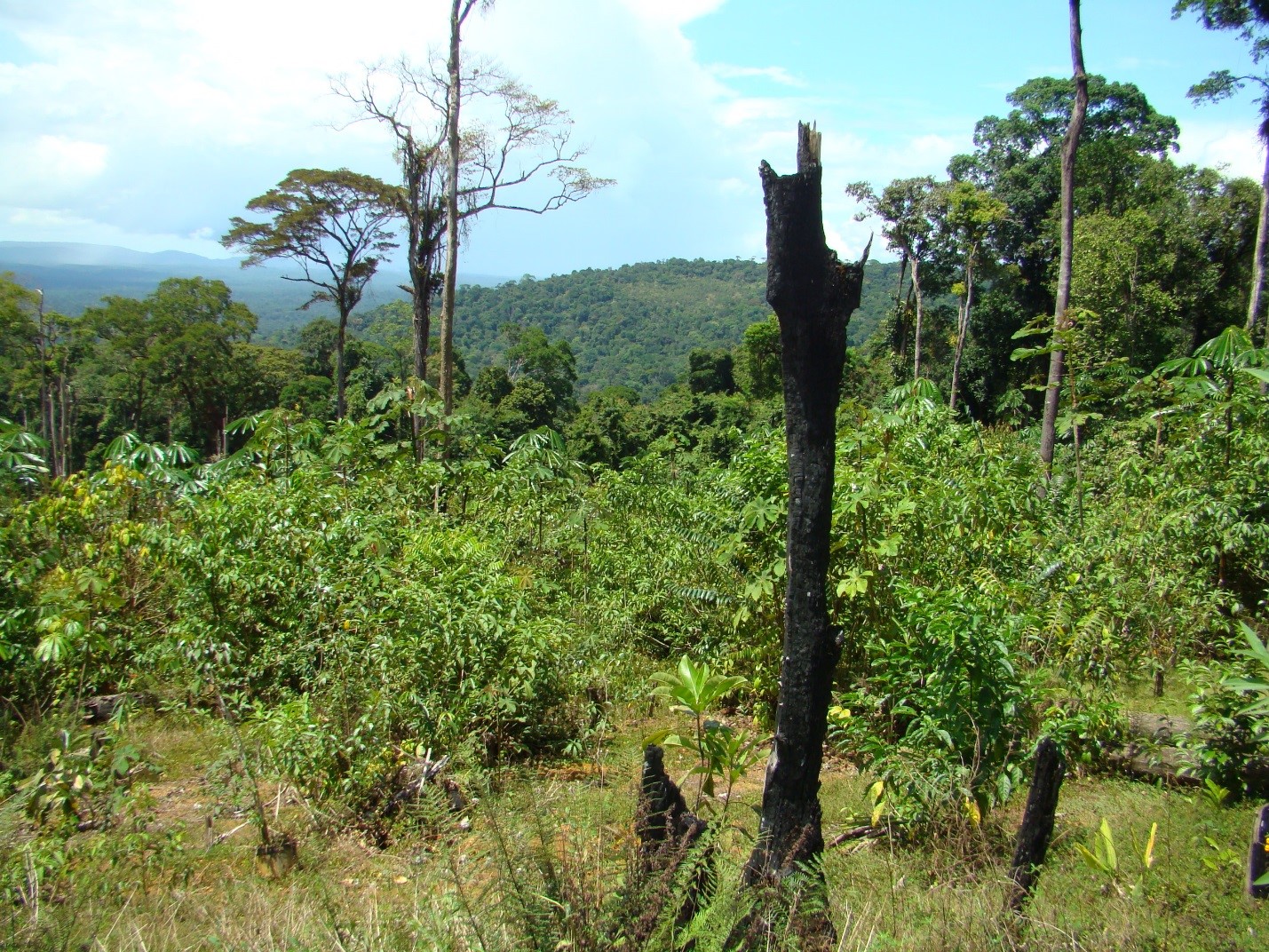 To conclude our project „Multiscale effects of disturbance on arbuscular mycorrhizal (AM) fungi“ led by David García de León we had a close view to the effects of local disturbance in tropical communities. In particular, we study the effects of clearcutting the rainforest, which caused big changes in the AM fungal communities in French Guiana. We also explored the effects of traditional agricultural management (slash-and-burn), and found small changes in the AM fungal communities of French Guiana when the rainforest was converted into traditional agriculture. If you want to know more about our findings, you can keep reading in this link
To conclude our project „Multiscale effects of disturbance on arbuscular mycorrhizal (AM) fungi“ led by David García de León we had a close view to the effects of local disturbance in tropical communities. In particular, we study the effects of clearcutting the rainforest, which caused big changes in the AM fungal communities in French Guiana. We also explored the effects of traditional agricultural management (slash-and-burn), and found small changes in the AM fungal communities of French Guiana when the rainforest was converted into traditional agriculture. If you want to know more about our findings, you can keep reading in this link
John Davison in China
July 2018
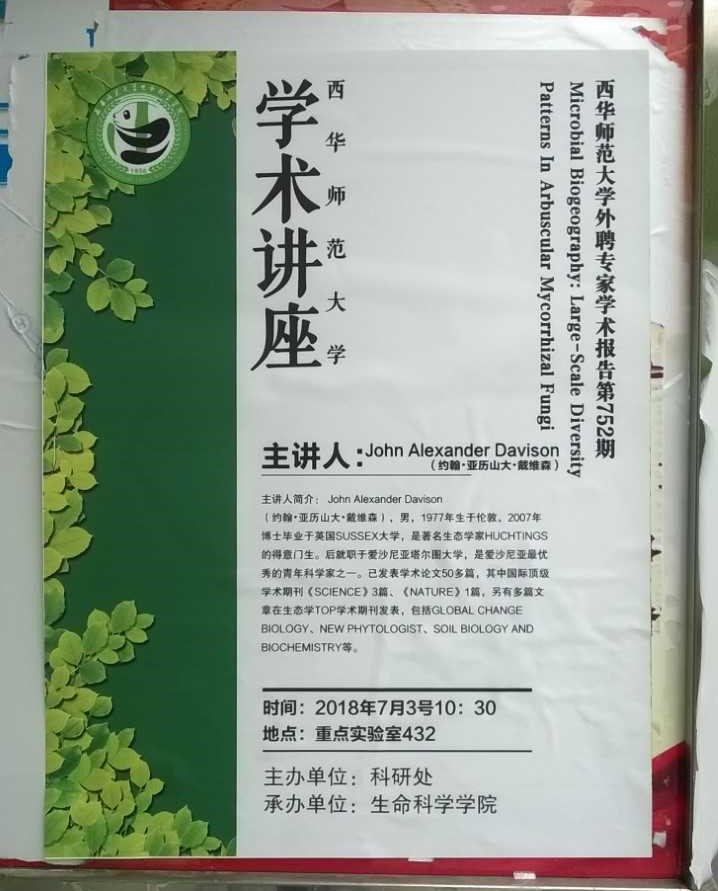
John Davison visited Sichuan Province, China, in early July to meet Chinese ecologists and deliver seminars on AM fungal biogeography and publishing ecological research. He gave presentations to research staff and postgraduate students at China West Normal University (Nanchong) and the Chinese Academy of Sciences (Chengdu). He also visited field sites – including arid scrubland and subtropical forest – on the edge of the Tibetan plateau.
Congratulations, Dr Lena!
June 2018
On the 6th of June, our dear Lena defended her PhD thesis „The dynamics of plant and arbuscular mycorrhizal fungal communities in grasslands under changing land use“ with flying colours! The oponent of the thesis was professor Catherine Gehring from Northern Arizona University. Lena gave a very exiting talk which was followed by an in-depth discussion and exchange of ideas. After the defence, we indulged ourselves with the lanscapes of Western-Estonia and also visited the study sites of Lena. We are very proud of you Lena! Wunderbar!
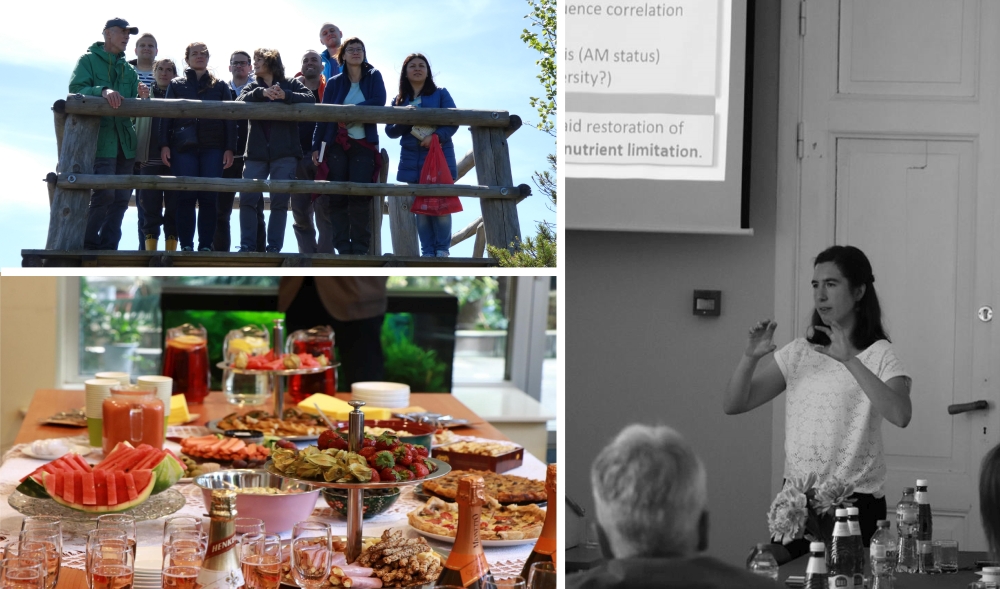
Journal Club retreat
May 2018
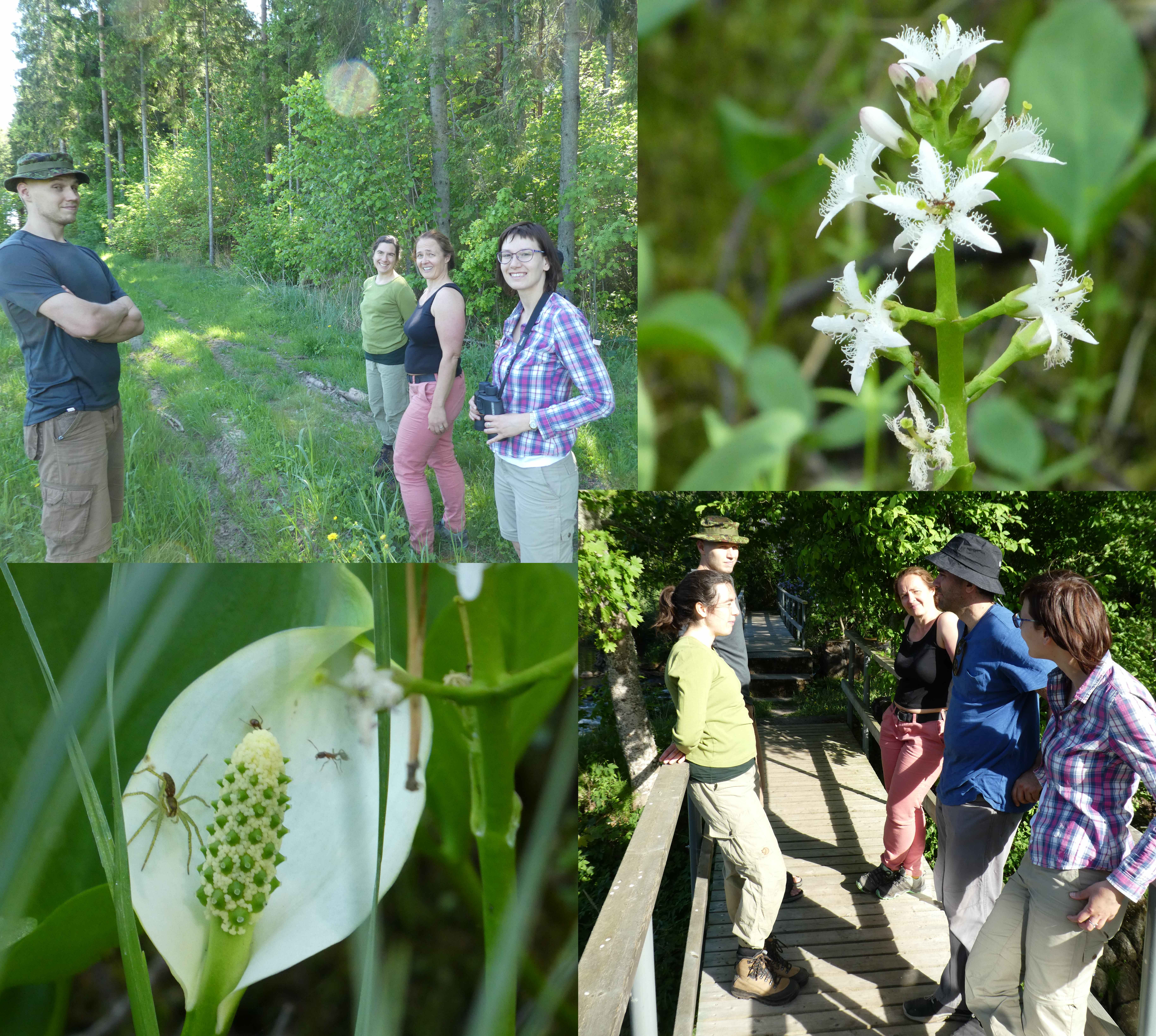 On the 25th of May our Journal club moved from the office to outdoors. It has become already a tradition to finish the academic year with a discussion in the nature. After hiking on the flooded meadows and forests near Elva river, we gathered in Mosina forest hut to look back at the year and talk about writing successful grant application. Thanks to the extraordinarily warm spring we also opened the season for swimming!
On the 25th of May our Journal club moved from the office to outdoors. It has become already a tradition to finish the academic year with a discussion in the nature. After hiking on the flooded meadows and forests near Elva river, we gathered in Mosina forest hut to look back at the year and talk about writing successful grant application. Thanks to the extraordinarily warm spring we also opened the season for swimming!
Spring mushroom workshop
May 2018
Plant Ecology Lab members Maarja, Tanel, Teele, Guille, Inga and Jane participated at the annual spring mushroom workshop which took place on May 18-20 on the Naissaare island. This small island on the North coast of Estonia impressed with it’s unique nature, and although mushrooms were not very abundant due to dry spring, there were plenty to study. We found various Gyromitras, Myxomycetes, Polypores, lichenized fungi etc.
Sample collection in India
April 2018
Researcher Inga Hiiesalu and doctoral student Tanel Vahter recently carried out fieldwork in India to supplement our database of arbuscular mycorrhizal fungal diversity accross the world. Sampling took place in humid subtropical forests, which span from the foothills of the Himalayan mountain range to central India. As a heatwave was making its way through India, the conditions were demanding and temperatures reached as high as 43 degrees celsius. Nonetheless, macaques, gray langurs, indian bison, peacocks and sambari deer could be spotted which made for an exiting time in the forest! The material collected will now be analysed using DNA-based methods to describe the distribution patterns of these microscopic fungi accross the globe.

Ecological Networks course in Mallorca
March 2018
From 21st to 23rd of March 2018, the Spanish Ecological Society (AEET) in coordination with the Mediterranean Institute for Advanced Studies (CSIC) and the University of Balearic Islands organized the first Spanish course on the analysis of Ecological Networks in Mallorca. The course was led by specialist the field: Anna Traveset,  Amparo Lazaro and Carlos Lara among others. It was oriented to plant ecology and interactions covering a solid introduction to the topic (from data sampling, the effective use of the main metrics, null models and validation techniques) and even explore interesting applications analyzing beta-diversity and environmental gradients from a network perspective. Our researcher, Guillermo Bueno, attended the course and discussed the current few mycorrhizal network studies in ecology and the potential of this technique in the field for the near future.
Amparo Lazaro and Carlos Lara among others. It was oriented to plant ecology and interactions covering a solid introduction to the topic (from data sampling, the effective use of the main metrics, null models and validation techniques) and even explore interesting applications analyzing beta-diversity and environmental gradients from a network perspective. Our researcher, Guillermo Bueno, attended the course and discussed the current few mycorrhizal network studies in ecology and the potential of this technique in the field for the near future.
Visitor from Serbia, University of Novi Sad
April 2018
In April, Dragana Stamenov from the University of Novi Sad visited us as a part of the COST Action KEYSOM. She was here to get acquainted with the techniques for both microscopic and molecular identification of arbuscular mycorrhizal fungi. While here, Dragana was supervised by PhD student Siim-Kaarel Sepp and specialist Jane Oja.
was here to get acquainted with the techniques for both microscopic and molecular identification of arbuscular mycorrhizal fungi. While here, Dragana was supervised by PhD student Siim-Kaarel Sepp and specialist Jane Oja.
Effects of disturbance on AM fungi out in Global Change Biology!
April 2018
Over ten years have gone by since Martin Zobel ,Mari Moora and other colleagues collected the first few  samples for the global dataset used in the project „multiscale effects of disturbance on arbuscular mycorrhizal (AM) fungi“. David García de León and John Davison have dedicated a large share of their last two years to analyse this complex dataset produced in-house by colleagues Maarja Öpik , Inga Hiiesalu and Kadri Koorem and international partners Yongjun Liu, Huyuan Feng and Cherdchai Phosri. On 24th March 2018, Global Change Biology published the main outcome of this project: a large-scale assessment comparing the AM fungal communities in the soils of disturbed and natural habitats. Today we have reached the understanding that anthropogenic disturbance reduces AM fungal diversity where natural diversity is high and increases diversity where natural diversity is low. Disturbance also favours ruderal AM fungal species. Altogether, these results mean that there is an urgent need to improve our understanding of AM fungal traits. If you are interested in the effects of disturbance on AM fungal communities, you can also keep reading our recent articles about Argentinean soybean fields and Estonian land use changes by PhD student Siim-Kaarel Sepp.
samples for the global dataset used in the project „multiscale effects of disturbance on arbuscular mycorrhizal (AM) fungi“. David García de León and John Davison have dedicated a large share of their last two years to analyse this complex dataset produced in-house by colleagues Maarja Öpik , Inga Hiiesalu and Kadri Koorem and international partners Yongjun Liu, Huyuan Feng and Cherdchai Phosri. On 24th March 2018, Global Change Biology published the main outcome of this project: a large-scale assessment comparing the AM fungal communities in the soils of disturbed and natural habitats. Today we have reached the understanding that anthropogenic disturbance reduces AM fungal diversity where natural diversity is high and increases diversity where natural diversity is low. Disturbance also favours ruderal AM fungal species. Altogether, these results mean that there is an urgent need to improve our understanding of AM fungal traits. If you are interested in the effects of disturbance on AM fungal communities, you can also keep reading our recent articles about Argentinean soybean fields and Estonian land use changes by PhD student Siim-Kaarel Sepp.
Advanced Statistics course in Sheffield
March 2018
 From 22nd to 26th January, the ATSC-NERC (Advanced Training short course funded by the Natural Environment Research Council of the UK) course Stage demographic models in ecology, evolution and conservation was held at The University of Sheffield. Our postdoc David García de León attended the course with a partial grant from NERC. There, David learned a lot about Integrative Projection Models (IPMs) from world- class ecologists Rob Salguero-Gómez, Mark Rees, Dylan Childs , and Steve Ellner among others. Now David is very curious about the life cycle of arbuscular mycorrhizal (AM) fungi, and is looking forward to apply population dynamics and IPMs to AM fungi!
From 22nd to 26th January, the ATSC-NERC (Advanced Training short course funded by the Natural Environment Research Council of the UK) course Stage demographic models in ecology, evolution and conservation was held at The University of Sheffield. Our postdoc David García de León attended the course with a partial grant from NERC. There, David learned a lot about Integrative Projection Models (IPMs) from world- class ecologists Rob Salguero-Gómez, Mark Rees, Dylan Childs , and Steve Ellner among others. Now David is very curious about the life cycle of arbuscular mycorrhizal (AM) fungi, and is looking forward to apply population dynamics and IPMs to AM fungi!
We thank the course organizers for a lovely time in Sheffield!
Soybean cultivation supports a diverse arbuscular mycorrhizal fungal community in central Argentina
March 2018
Arbuscular mycorrhizal (AM) fungal diversity is expected to be low in anthropogenic ecosystems. However, a recent study by our postdoc David García de León and colleagues found only small differences in this respect between soybean fields and nearby pristine forests. They compared AM fungal communities in the roots of 12 host plant species and in soil from mature forests and soybean fields in Central Argentina. They found that AM fungal richness and community composition were affected by host plant identity. Conyza bonariensis (Asteraceae, facultative AM plant) was associated with the greatest number of AM fungal species. By contrast, Cestrum parqui (Solanaceae, mycorrhizal status unknown) was associated with the lowest number of fungal species. Also, high AM fungal richness was associated with low P and N concentration in soil. Regardless of soil chemical properties, soybean fields contained more easily cultured AM fungal taxa (ruderals) than forests. These results mean that fungal communities in agricultural landscapes can be as diverse as in natural systems, but are composed of rather different fungi, which in turn can function differently from fungi in the natural habitats.
Relatedness with plant species in native community influences ecological consequences of range expansions
March 2018
 Current global change enables many species to expand their range to higher latitudes. Relatively little is known about the effect of these range-expanding species in their new range and it is proposed that some of these species will become problematic, invasive, in the future. Our researcher Kadri Koorem, with her collegues from NIOO-KNAW demonstrated that the ecological impact of a range expanding plant species can depend on its relatedness with native flora. In their article, Kadri and her collegues found that while range-expanding plant species with and without close relatives in their new range suppressed the growth of native insect, only range expanders without close relatives suppressed the growth of selected native plant species. Improved knowledge about the effects of range-expanding plant species can help to improve the predictions about the functioning of future communities.
Current global change enables many species to expand their range to higher latitudes. Relatively little is known about the effect of these range-expanding species in their new range and it is proposed that some of these species will become problematic, invasive, in the future. Our researcher Kadri Koorem, with her collegues from NIOO-KNAW demonstrated that the ecological impact of a range expanding plant species can depend on its relatedness with native flora. In their article, Kadri and her collegues found that while range-expanding plant species with and without close relatives in their new range suppressed the growth of native insect, only range expanders without close relatives suppressed the growth of selected native plant species. Improved knowledge about the effects of range-expanding plant species can help to improve the predictions about the functioning of future communities.
North-European Forest Mycologists meeting in Uppsala
February 2018
On 8-9th of February, the NEFOM (North-European Forest Mycologists) network
held an annual conference- style meeting. We were represented at the meeting with talks by Maarja Öpik (AM-fungi in temperate forests) and Tanel Vahter (AM fungi following a forest – a restoration perspective) along with Estonian colleagues Leho Tedersoo and Urmas Kõljalg. During the meeting, an overview on the current knowledge of forest mycology and the problems related to intensive management was given. Maarja and Tanel also brought in a less-known, arbuscular mycorrhizal perspective of temperate forests.
style meeting. We were represented at the meeting with talks by Maarja Öpik (AM-fungi in temperate forests) and Tanel Vahter (AM fungi following a forest – a restoration perspective) along with Estonian colleagues Leho Tedersoo and Urmas Kõljalg. During the meeting, an overview on the current knowledge of forest mycology and the problems related to intensive management was given. Maarja and Tanel also brought in a less-known, arbuscular mycorrhizal perspective of temperate forests.
Tanel also attended a course held after the meeting where newest methods and knowledge about sample preparation for high throughput sequencing were discussed in conjunction with practical exercises. During the week, various sequencing platforms were introduced along with their pros and cons.
We thank the meeting and course organisers for a lovely time in Uppsala!
Effects of land use on arbuscular mycorrhizal fungal communities in Estonia
February 2018
 While the species richness of arbuscular mycorrhizal (AM) fungi may not differ among natural, semi-natural and degraded habitat types, the fungal community shifts with land use change. A recent study by PhD student Siim-Kaarel Sepp and co-authors compared AM fungal communities in soil and roots of a single host plant species in six different habitat types in Estonia, ranging from boreonemoral forest to calcareous grasslands (alvars). They show that both land use intensification (e.g. clearcutting) and abandonment (e.g. overgrowing) cause shifts in AM fungal communities. Furthermore, the AM fungal communities in roots of the single host plant species were more similar among different habitats than in soil samples, suggesting that the host plant may select a suitable fungal partner community from the available selection of AM fungi.
While the species richness of arbuscular mycorrhizal (AM) fungi may not differ among natural, semi-natural and degraded habitat types, the fungal community shifts with land use change. A recent study by PhD student Siim-Kaarel Sepp and co-authors compared AM fungal communities in soil and roots of a single host plant species in six different habitat types in Estonia, ranging from boreonemoral forest to calcareous grasslands (alvars). They show that both land use intensification (e.g. clearcutting) and abandonment (e.g. overgrowing) cause shifts in AM fungal communities. Furthermore, the AM fungal communities in roots of the single host plant species were more similar among different habitats than in soil samples, suggesting that the host plant may select a suitable fungal partner community from the available selection of AM fungi.
The role of plant mycorrhizal type and status in modulating the relationship between plant and arbuscular mycorrhizal fungal communities
January 2018
 Interactions between communities of plants and arbuscular mycorrhizal (AM) fungi shape fundamental ecosystem properties. Experimental evidence suggests that compositional changes in plant and AM fungal communities should be correlated, but empirical data from natural ecosystems is scarce.
Interactions between communities of plants and arbuscular mycorrhizal (AM) fungi shape fundamental ecosystem properties. Experimental evidence suggests that compositional changes in plant and AM fungal communities should be correlated, but empirical data from natural ecosystems is scarce.
PhD student Lena Neuenkamp and co-authors fill this gap of knowledge with their recently published study in New Phytologist, where they clearly show that compositional changes of plant and AM fungal communities were correlated across three stages of grassland succession. The authors also reveal that strength of plant-AM fungal correlation weakened during succession following cessation of grassland management, which was brought about by changes in the proportion of plants exhibiting different AM status. Plant-AM fungal correlation was strong when the abundance of obligate AM plants was high, and declined as the proportion of facultative AM plants increased.
The findings of this study indicate that the extent to which plants rely on AM symbiosis can determine how tightly communities of plants and AM fungi are interlinked, regulating community assembly of both symbiotic partners. Further, the results of this study imply that restoration of ecosystems with obligate AM plant dominated vegetation, such as calcareous grasslands, might benefit from the re-introduction of local AM fungal communities, especially if the ecosystem is already heavily degraded.
Early Shrove Tuesday!
January 2018
 Since we have decent snow cover this year in Tartu, the teams of Plant Ecology and Macroecology decided to bond by sledging down the hill. Sledging is a traditional Shrove Tuesday activity in Estonia (this year it will be on 13th of Feb), and is considered to bring good luck, the longer the slide is. We tested various items for sledges: pizza boxes, cardboard boxes, trashbags, old posters... Hopefully our long slides will bring us good luck in the article submissions this year!
Since we have decent snow cover this year in Tartu, the teams of Plant Ecology and Macroecology decided to bond by sledging down the hill. Sledging is a traditional Shrove Tuesday activity in Estonia (this year it will be on 13th of Feb), and is considered to bring good luck, the longer the slide is. We tested various items for sledges: pizza boxes, cardboard boxes, trashbags, old posters... Hopefully our long slides will bring us good luck in the article submissions this year!
Ancient environmental DNA reveals shifts in dominant mutualisms during the late Quaternary
January 2018
Recently, an eDNA metabarcoding data set was used to describe northern high-latitude vegetation during the past 50,000 years. Here, Zobel et al. use the data set to examine how the abundance of key plant mutualistic traits (mycorrhizal type and status, N-fixing ability, pollination type) changed during this period and discuss possible environmental drivers.
2022: march, august
2021: february, may, august, september, october
2020: february, august, september, december
2019: january, february, march, april, june, july, september, november
2018: january, february, march, april, may, june, july, october, november, december
2017: january, february, march, april, may, june, july, august, september, october, november, december
2016: january, february, march, april, may, july, august, october, november, december
2015: january, february, march, april, may, july, august, september, october, november
2014: january, february, may, july, august, september, november, december
2013: january, february, april, may, june, august, september, october, november, december
2012: january, february, march, april, may, june, august, september, october, november, december
2011: may, june, september, october, november

